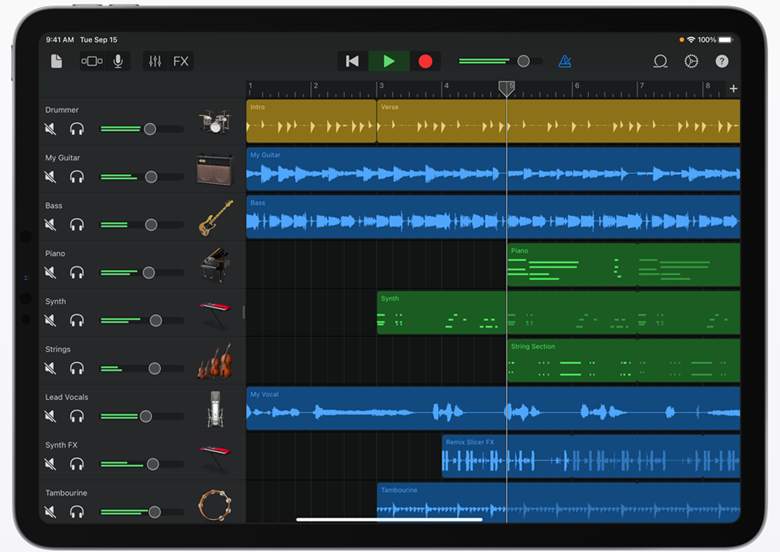Tech column: Assistive music technology
Gawain Hewitt
Wednesday, July 19, 2023
Accessible musical instrument specialist Gawain Hewitt surveys the latest digital tools.

Apple
What is a musical instrument and who gets to be a musician? These are themes that have continually run through my practice as a maker of music, a builder of musical instruments and an educator. This is particularly relevant as the Social Model of Disability tells us that people are disabled by barriers in society, not their impairment.
In my experience, accessibility in music-making can be a creative practice in itself. When it's done well, it benefits everyone as it allows us to focus on getting into the music-making straight away, rather than being prescriptive about what form it should take. While I can be as invested in the canon of musical instruments and musical history as the next person, I find it exciting to be fluid in my approach to musical instrument design. When we are, it can make space for something new and open our worlds in very exciting ways.
Using iPads
A great way to begin to explore is with an iPad. iPads changed the landscape of accessible music-making. They are responsive, portable, have built-in speakers and there are literally thousands of music apps to explore. Here are my top three to get you started:
- GarageBand is made by Apple and is free. It contains a suite of playable musical instruments including guitar, strings and piano. Use them for adaptable, playable musical instruments which have a clear link to the real world. What is particularly helpful is the settings in the Chords view. Key Signature sets the harmonic world, and the Edit Chords feature allows you to choose which note to assign to each playable strip. Another nice feature is that if you set all dials to none, then the strip disappears completely.
- ThumbJam has been around for a long time and is a consistently reliable and playable instrument. The developers have gone to considerable effort to ensure it still works on older iPads (which is not a given). The built in sounds are well considered, with authentic sound and intelligent gesture control, using finger vibrato and tilt for added expression, and it has a build-in feature to make your own sounds. For customisation, I use the span controls to change the interface size, allowing for greater or lesser sensitivity in the playing interface. This can make a small gesture very expressive, or conversely make the interface more forgiving if precision is an access barrier.
- BeatBlocks is a new app that allows you to build musical patterns with anything colourful in the real world. Firstly, you place colourful items in the view of your iPad camera, and it assigns sounds to them. Designed for Lego, I found myself making a beat with oranges and a chocolate bar this week, and I have plans to use it with a whiteboard and post-it notes next week. A completely different and playful approach to rhythm, this could be used to get a whole class involved in making a musical pattern.
Drawbacks
However, the problem with iPads is that they are expensive and only accessible if you can interact with a touch screen. Also, you may not have iPads. This has inspired me to develop some free web-based musical instruments. Brilliantly, these work on most internet-enabled devices, including android tablets, phones and laptops allowing keyboard and mouse use. You can use them online and in computer suites, and they can be more accessible for Blind or partially-sighted people. Because the instruments are online, students can access them at home on their phones or computers.
Another challenge when working with touch screens is that you can accidentally leave an app or change a setting. Guided access on Apple devices allows you to lock the app, and even switch off areas of the screen that you want ignored. If you are using an Android device, pinning allows you to stay in the app, but you can't modify the screen in the same way.
Physical alternatives
Away from screens, there are of course physical musical instruments that have considered accessibility in their design. A new instrument that is winning awards is called CMPSR – a device based on a joystick that controls sound and music through a computer or iPad. It completely rethinks musical instrument design and allows young people to use skills honed in computer gaming or even wheelchair driving and transfer them to musical expression. Lots of thought has gone into how it can be used in schools and education, including a custom notation system and schemes of work. Most importantly, though, it's really fun!



Final thoughts
Bearing all these approaches (and more) in mind, it is really important to take a pupil-centred approach and avoid making assumptions about people's access needs. I suggest that you set up sessions to explore accessibility together. Expect things to change as people change and get used to new ways of doing things. This is a journey, not a destination. Just because a traditional instrument isn't accessible, doesn't mean that someone can't aspire to play it – we're all in the same world with the same cultural signals. Our job as teachers may be to make something entirely radical and new, or it may be to try to find a way to make the French Horn accessible, or indeed anything in between.
Apple Guided Access: support.apple.com/en-gb/HT202612
Soundmakers: orchlab.org/soundmakers
CMPSR: digitmusic.co.uk/product/cmpsr
GarageBand: apple.com/uk/ios/garageband
ThumbJam: thumbjam.com
BeatBlocks: beatblocks.app



